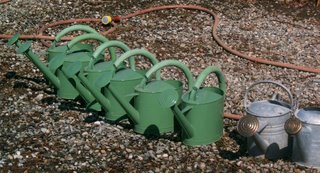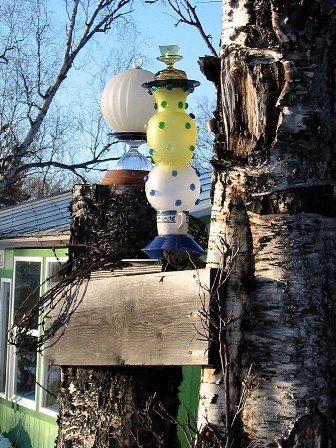Every spring I get a raft of phone calls asking about dead plants. No, people aren’t asking to buy them, they just want to know why something looks dead when it looked so great in the fall. While I’m not Sherlock Holms, or even Miss Marple, it often boils down to one thing. Fall water, or a lack thereof.
When I ask if the plant went into winter with good, moist soil, I usually get a long pause followed by, “What do you mean by that?”
This time of year it seems like it’s always wet outside. Fog, mist, cool evening temperatures causing heavy morning dew, quite a few clouds; these all give us the impression that we are experiencing moisture. Remember, we are above ground and we feel cool and damp, but the life of a woody plant is all about what’s happening underground.
Two weeks ago I was digging (chipping would be a more apt description) on a steep hillside in an attempt to create what I hoped to be a really amazing staircase of rock and aggregate. The hillside is primarily hard packed shale and concrete-like mud. Just inches below the surface it was so dry and hard that I needed a pounding bar just to loosen the surface. (Remember – everyone has been complaining about how wet our weather has been!) For several days I chipped away at the ground with my bar and scooped out the freed bits with my hands. Not a lot of fun! Making no progress, and having tons more productive things to do, I walked away from the never-to-be-finished-much-less-started staircase and stayed away for a week. In the mean time it rained - long, hard, healthy rain! I rallied myself for another attack this week and to my shear joy I was rearranging dirt on the hill like a giant gopher! One long rain made all the difference! The soil was soaked down at least two feet, and a thrill to work in. Yes, I know; being bent over nasty ground on a hillside too steep to perch on, pitching dirt, is not a thrill for everyone, but I was in heaven!
As you guessed, or at least I hope you have
 , all of this is to illustrate a point. Moisture matters! In this case it loosened the ground and made my job easier, but in the case of roots, it can literally mean life or death. While we are in a frenzy changing tires, putting on snow blades and getting ready for winter, our plants are quietly doing the same. They need to be at their healthiest right now; plump cells full of stored energy with fleshy, thick roots, not emaciated drought shriveled ones. The trouble is it’s all happening underground. They don’t show the outward signs of drought as they do in the heat of the summer, and it’s not likely they’ll holler at us, “Hey! We need water over here!” They just keep quiet, look stoic and die in the spring.
, all of this is to illustrate a point. Moisture matters! In this case it loosened the ground and made my job easier, but in the case of roots, it can literally mean life or death. While we are in a frenzy changing tires, putting on snow blades and getting ready for winter, our plants are quietly doing the same. They need to be at their healthiest right now; plump cells full of stored energy with fleshy, thick roots, not emaciated drought shriveled ones. The trouble is it’s all happening underground. They don’t show the outward signs of drought as they do in the heat of the summer, and it’s not likely they’ll holler at us, “Hey! We need water over here!” They just keep quiet, look stoic and die in the spring.Trees and shrubs in the apple (Malus) and prune (Prunus) familes are quintessential for this. These include eating apples, rose-tree-of-china, and nanking cherry. They often begin to get nice leaf and flower buds then suddenly shrivel. Soon the wood begins to dry and dark spots appear on the bark. The once puffy buds are now dried and the branch tips are crispy. The fact is, their roots are too damaged from winter freeze and they can not feed themselves. Once all stored energy is gone, they go kaput!
A number of evergreens such as Norway and Colorado spruce and many juniper are especially susceptible. Surprisingly, even our native birches are not safe. Their particularly wide platter roots can suffer fall drought with ease. They leaf out in the spring, after which it is common to see the tops of the trees looking dead. Looking around our forest with this in mind says a lot about our past several summers without the need to have experienced the weather first hand.
So! You’re not quite through watering yet. I’m not talking about daily watering, just keeping the ground nice and moist until it is frozen. And don’t forget your friends that are planted under eves or other obstructions. This may require some awareness on your part and perhaps a hose hook up once in a while, but just think - you won’t have to wonder why your orchard looks like a graveyard next spring.



1 comment:
Thank you so much for posting on my blog so that I could discover yours!
I'm always looking for information on gardening specific to Alaska. The fact that yours provides it with a rollicking sense of humor is a huge plus!
Thanks again!
Post a Comment